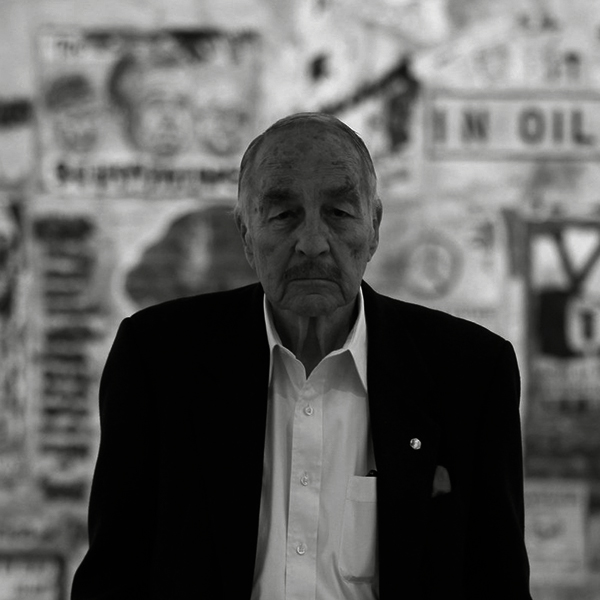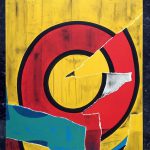
Who is Burhan Doğançay? (1929-2013)
Who is Burhan Cahit Doğançay, who is known for integrating the walls he observed in various cities of the world into his works of art? Who bought his most famous painting, Blue Symphony, and for how much TL? Here is the exemplary life story of Burhan Cahit Doğançay.
Burhan Doğançay was born on September 11, 1929 in Istanbul. He received his first art education from his painter father Adil Doğançay and another painter Arif Kaptan. Moreover; Doğançay played football for Gençlerbirliği in his youth. After graduating from Ankara University Faculty of Law in 1950; He attended art courses at the Académie de la Grande Chaumière in France between 1950 and 1955, and received his doctorate in economics from the University of Paris in 1953. Doğançay chose the city walls, which he had admired since the early 1960s, as the subject of his works. He evaluated the walls, which are exposed to weather conditions and abrasions, as an indicator of the passing time, often with the pulse scale of our societies and the traces that reflect people’s feelings of the city. In Doğançay’s words, this passion started with something that caught his eye while walking on 86th Street in New York one day:
“It was the most beautiful abstract painting I have ever seen. There were patterns of scraps of a poster and fragmentary shadows coming from its surface and forming on the wall. It was mostly orange with a little bit of blue and green and brown. “There were also marks on it caused by rain and mud.”
During this period, he continued his painting studies and presented his works in several group exhibitions. Later; He started photography in the 1970s and set out to photograph city walls around the world. As a city explorer, Doğançay has become familiar with the art of texture covering the surfaces of walls in various cities of the world for half a century. City walls are the codes of social, political and economic changes and, in this context, documents that reflect the atmosphere of the regions and the spirit of the time. Part of the inner spirit of his work is the suggestion that nothing is ever as it seems. Since Doğançay's art is wall art, the sources of his subject are also real. Therefore, he cannot be described as an abstract artist. Yet at first glance, much of his work appears abstract. Doğançay's approach is based on shaping decorative models by researching natural data and viewing the qualities of the elements. In this context, he continues with the decollage strategies he constantly formulates, and effectively disrupts and remakes the content of the nouveau réalistes positions. Although Doğançay started out as a simple observer and recorder of the walls, in a very short time he reached the point where he could express comprehensive ideas, impressions and emotions in his works. His foresight continued to expand with his efforts in both content and technique.
Burhan Doğançay died at the American Hospital in Istanbul, where he was treated. Burhan Doğançay, who is 84 years old, was buried in the Karabakh Cemetery in Turgutreis, Bodrum.
Walls of the World
In the mid-1970s, Doğançay attempted to take photographs of city walls in our world, which he described as his second project. While these photographs, which he calls "Walls of the World", constitute an archive of our time and the core of his works, they are essentially documentaries of the period we live in. The focus of his "encyclopedic" approach is directed specifically to the structures, signs, symbols and images that people leave on the walls. This is not for lack of creativity, but because he finds the human condition to be completely inclusive, without any cultural, racial, political, geographical, or formal boundaries. Doğançay himself stated the essence of these discoveries with the words "Walls are the mirror of society." His resulting practice is comparable to other "documentarians" such as August Sander (portraits) and Karl Blossfeldt (plants) in his ability to capture what most interests him about the fundamental subject, through his restraints and obsessions. His photographs are not just photographs taken with the aim of capturing the moment, but with their meticulously detailed surface segmentations, masterful examination of colors, structures, light and materials, they are sometimes monochrome-like in their radical reductionism. This project has grown in both content and importance over the last forty years, with some 30,000 images from 100 different countries on five continents. In 1982, images from his archive were exhibited as a one-man show at the Center Georges Pompidou in Paris and were subsequently viewed at the Palais des Beaux-Arts in Brussels and the Musée d'Art Contemporain in Montreal.
Painting and Collage
Since the objects and posters he collected from the walls were the main materials he used in his art works, it is logical that Doğançay generally preferred collage and, to some extent, fumage. In addition to city billboards and graffiti-covered wall surfaces, Doğançay also recreated and revitalized entrances such as neglected or broken windows and doors in his various series. The only masters to whom he compared himself in the last brave period of art, with whom he had experience and was an intense participant, were Robert Rauschenberg and Jasper Johns. Despite this, Doğançay preferred to repeat the relationships of the particles on the wall surfaces with each other, with minimal compensations in color and position, exactly as he found it, rather than randomly combining or subverting them in the Raushenberger style.
He executed his work in a simulated manner, largely in the spirit of record-keeping, not with the eye of a vulture but rather with the eye of a collector. His works often evoke with an alienated feeling the wear and tear and destruction of the city, and the fact that city life has become miserable and out of control in a way that cannot be replaced again. His pictorial fragments are often separated from their original content and rearranged, sometimes in incomprehensible combinations. Therefore, all of the artist's works, with their complex and equally experiential variations, will always cover everything from photographic realism to abstraction, from popular art to visual/fiction/collage. Unlike his Cone Series, Door Series or Alexander's Walls, which consist of clean strips of paper and their calligraphy shadows, he gained fame and fame in the 1970s and 1980s with his Ribbon Series, in which he interpreted city walls bearing his distinctive signature. These extremely vibrant, curved and curvilinear shapes seem to spring from the flat and solid-coloured backgrounds, and these graceful ribbon-like shapes take on a three-dimensional quality, especially indicated by the implied shadows. These series subsequently led to the works of Alicoband-aluminum composite shadow sculptures and Aubusson tapestries.
Hindibağ Lithography
In 1969, Henry Geldzahler, then Head of the 20th Century Arts Department at the Metropolitan Museum of Art in New York, provided Doğançay with a scholarship for the Tamarind Lithography Workshop at the Tamarind Lithography Workshop Institute in Los Angeles. Founded by June Wayne, the Workshop was attended by approximately seventy artists between 1960 and 1970, including Ed Ruscha, Jim Dine, Josef Albers and Louise Nevelson. The work was a ten-year project designed to promote the art of lithography in the United States. Doğançay created a total of sixteen lithographs, including his impressions of a series of eleven pieces titled "Walls V", and marked an important turning point in his career, as he communicated essentially with monotony. In these workshops, he was forced to abandon his haphazard approach, partly due to the necessity of the tools used, and preferred to organize his works graphically, inspired by the raw objects that were his subject. The discipline imposed led to more distinct flat surfaces and vibrant colors within his images, helping him create remarkable new effects that stand out. His new evaluations enabled Doğançay to resolve any discrepancies that might have arisen between his subject and his method, and were a profound factor in his subsequent evolution. The visual strokes he interprets with vivid color tones are the main feature that determines the truth of the city contradictions that he wishes both himself and the viewers of his works to perceive.
Aubusson tapestries
In Paris, Doğançay was introduced to Jean-François Picaud, the owner of L'Atelier Raymond Picaud in Aubusson, France. Picaud was fascinated by Doğançay's Ribbons series, which could be an ideal subject for tapestries, and immediately invited Doğançay to submit several large drawing sketches. In the words of Jean-François Picaud, "The art of wall weaving found its pioneer in the 21st century in Burhan Doğançay." The first three Doğançay tapestries woven in 1984 were an instant success.
Doğançay Museum
Doğançay Museum, which is especially dedicated to the works of Burhan Doğançay and a small part to the paintings of his father Adil Doğançay, exhibits approximately 100 works created by the artist from his student years until today, where various artistic stages are evaluated retrospectively. Founded in 2004 and located in the Beyoğlu district of Istanbul, Doğançay Museum is considered the first contemporary museum in Turkey.
Art Market
In November 2009, one of his paintings, Blue Symphony, was purchased by Yıldız Holding manager Murat Ülker for 1.7 million Dollars/2.2 million TL. This collage is connected to Doğançay's Cone series, Ribbon series, which are a turning point in his impressive series of works that he created with conscious developments and left a mark, and the works of city spaces that he explored with enthusiasm. Doğançay enters into a dialogue with the history of Turkey in his work Blue Symphony, which is his largest and most impressive work, along with his sister works Magnificent Period (in the Istanbul Modern collection) and Mimar Sinan (in the private collection). This work was created for the First Istanbul Biennial in 1987. Istanbul Modern commissioned composer Kamran İnce to compose the Blue Symphony as music, and the world premiere of this composition was played by Hüseyin Sermet in solo piano style on 26 June 2012. Doğançay's work called Blue Beauty from the Cone Series was sold for 1,050,000 Turkish liras at Antik AŞ in Istanbul.








































